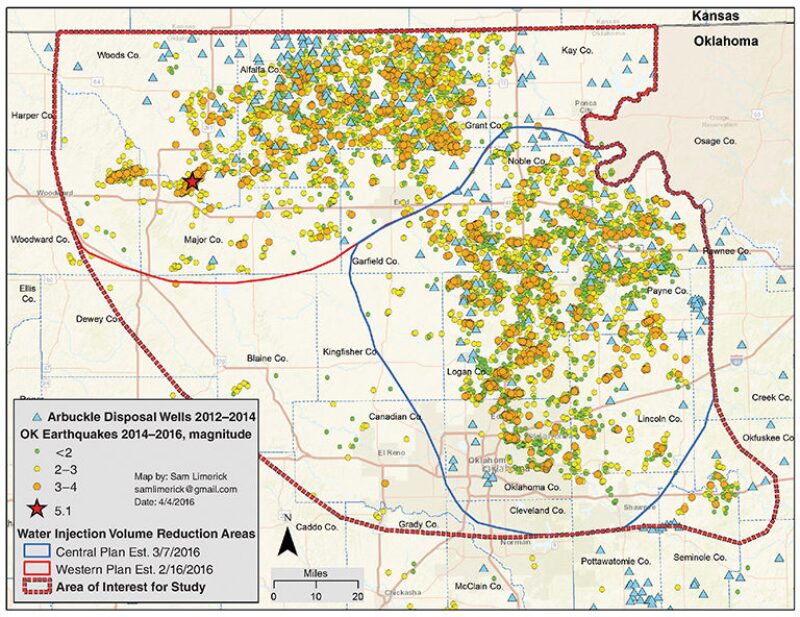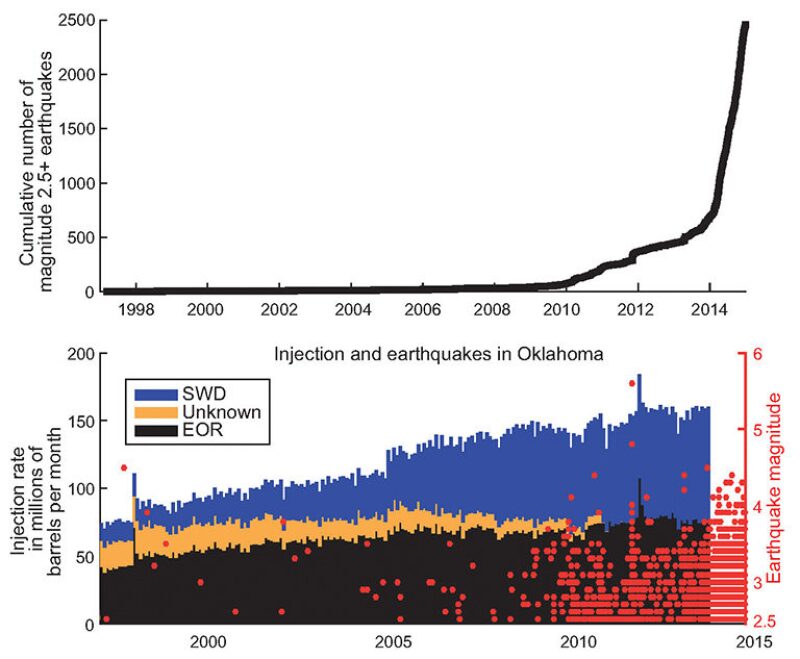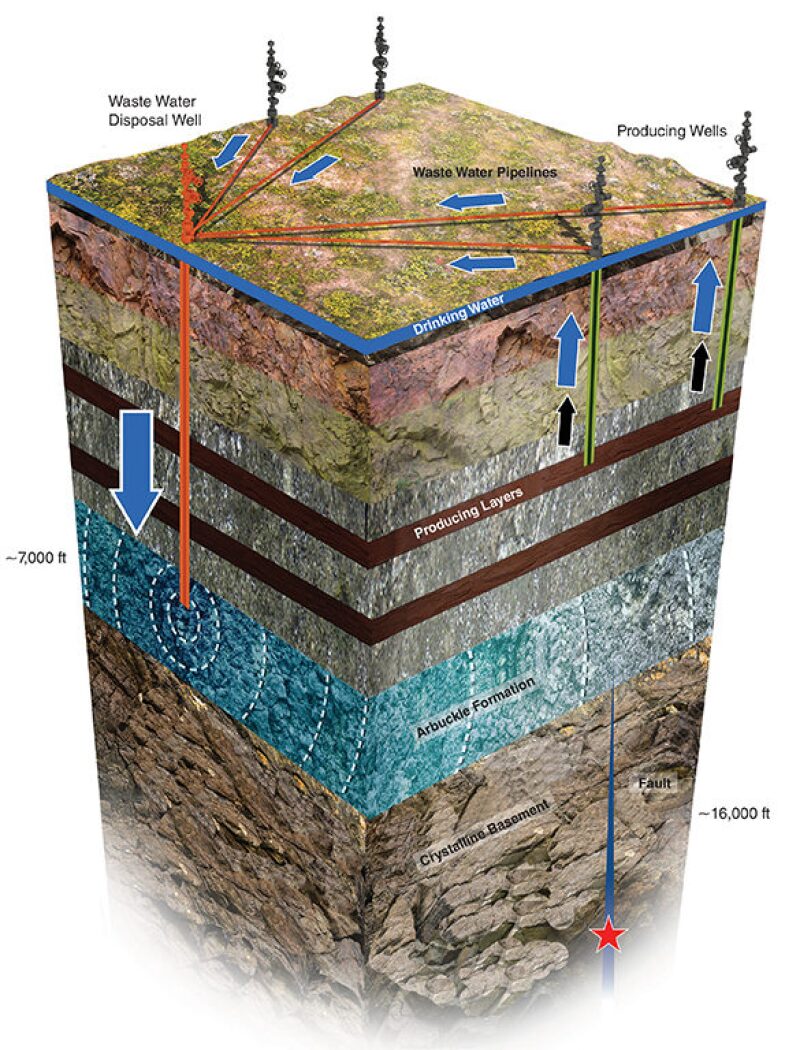Industry regulators in Oklahoma have rolled out broad new restrictions on more than 600 disposal wells as part of the largest action of its kind taken in response to earthquakes.
An additional 118 wells have been included in an “area of interest” and face increased reporting and monitoring requirements. Altogether, the plan affects approximately 20% of the state’s disposal wells and marks a major change for the fourth-largest oil- and gas-producing state in the US.
The Oklahoma Corporation Commission, the state’s industry regulator, spent a year issuing volume reductions and shut-ins at a number of specific disposal sites, efforts that failed to slow the rising rate of earthquakes. Then on 13 February, the third-strongest earthquake in Oklahoma history shook homes across the state and was felt hundreds of miles away by residents of three neighboring states. No serious damage or injuries were reported. But just days after the 5.1 magnitude trembler, regulators abandoned their pinpoint approach and announced a “regional earthquake response plan” that covers approximately 10,000 sq miles—an area twice the size of Qatar.
For the foreseeable future, no new disposal well permits will be granted in the restricted zone, and operators must curtail fluid injections into existing wells by 40% of their 2014 average rate. Based on last year’s figures, that means a reduction of fluid injection of approximately 300,000 B/D.
Because water disposal is a necessary component of oil and gas operations, the immediate scarcity of disposal wells may drive up fees at sites operated by third parties. Recycling or trucking the water outside of the restriction zone are expensive options that few operators can afford right now.
If there are no feasible alternatives, ongoing production declines may accelerate in the Mississippian Lime, the most significant play affected by the order. The play is a carbonate formation, and unconventional techniques are used to recover oil and gas from it. Last year, production in the Mississippian Lime was estimated to be around 100,000 B/D, which accounted for a quarter of the state’s overall production.
The play is notable for being the leading water producer in the state. To handle all the produced water, along with much smaller fractions of drilling and fracturing fluids, operators have spent millions of dollars on drilling a vast network of disposal wells.
As they do around the world, disposal wells in Oklahoma allow companies to efficiently and cheaply dump billions of barrels of waste water a year deep into the ground. In most locations, this is a safe and standard practice.
But when the volume of water being injected in Oklahoma soared to new levels, so did the rate of earthquakes—now 600 times higher than it was before 2008, according to the Oklahoma Geological Survey (OGS). The consensus among regulators, scientists, and many industry experts is that wastewater injections are the root cause of the earthquakes, a process termed induced seismicity.
It could take several months for regulators to decide if their current plan has worked. If it fails, then some experts expect to see even tighter rules or an outright moratorium on injections. There are also those who believe that reductions are not the solution; instead, a better understanding is needed of where disposal wells will have little or no chance of triggering fault slips.
Mississippian Lime in Trouble
Only 4 years ago, the Mississippian Lime was hyped up as the next Bakken Shale, a bold prediction that missed the mark by a wide margin. Operators have struggled to make the play a commercial success and though the latest restrictions seem to cast more dark clouds over the Mississippian Lime’s future, low oil and gas prices are likely to mask any immediate impact.
Richard Zeits, founder of Zeits Energy Analytics, researches shale operators for investors and said a number of producing wells are likely to be shut in as a result of the new constraints. But he also noted that production in the area is already on course to decline by 20% or more by the end of this year.
“Even without regulatory restrictions,” he said, “there are many questions with regard to what threshold oil price might be required for [the Mississippian] Lime to be a profitable play.”
Initially, the Mississippian Lime was seen as a “perfect application for horizontal drilling,” according to an OGS report written in 2012 when activity levels were starting to ramp up. A year later drilling activity peaked and several companies sold off their entire positions at fire-sale prices.
The play’s largest producer and operator of a number of disposal wells, Oklahoma City-based SandRidge Energy, doubled down around that time and acquired more core acreage leases. In March, the company said it may not survive for much longer. If that is the case, SandRidge would be the largest shale producer to file for bankruptcy protection since the downturn began.
Operators competed for large swaths of the play that spans both Oklahoma and Kansas knowing it had higher than normal water cuts. In addition to high oil prices, they believed the water handling costs would be offset by lower drilling and completion costs. Many areas of the Mississippian Lime are considered shallow compared with other plays (between 1,600 ft and 7,000 ft) and since it is a carbonate as opposed to a shale, it is easier to drill through and requires lower horsepower rigs.
But the more operators got to know the Mississippian Lime, the less they liked it. Wells depleted too quickly and due to its remoteness, companies faced spending tens of millions of dollars on power lines needed to run pumps for lifting and disposal.
And the water cuts were not just higher than normal, they were often extraordinarily high. Newly completed oil wells have been known to pump out as much as 98% water at a rate of thousands of B/D. Those who have worked the Mississippian Lime sometimes quip that it is really a water aquifer with just a little bit of oil sitting on top.
Even if prices rise enough to make the play profitable, the disposal limits will essentially act as a cap on future oil production. And as bad as things are now, they could always get worse if further limits are put in place. Zeits said the biggest risk facing operators is the uncertainty about how the situation will play out and whether the response plan meets its objective.
“If there are more big earthquakes, the regulators may have little choice but to impose even stricter rules,” he said. “I am not saying this will happen, but if it did, the impact on production and cash flows would be potentially a lot more severe.”
Legal Faults Widening
The spike in Oklahoma’s seismic activity prompted the US Geological Survey to recently issue its first 1-year forecast for earthquake hazards in the continental US. The federal agency, whose seismic risk assessments are used to develop building codes and guide policy makers, said Oklahomans face a 5% to 12% chance of incurring minor home damage “such as fallen plaster or cracks in the walls” due to an earthquake induced by injections. It is the same risk level assigned to naturally occurring earthquakes in the seismically active state of California.

Keith Hall, a professor and director of the Mineral Law Institute at Louisiana State University, presented a technical paper on the legal risks associated with induced seismicity at last year’s SPE Hydraulic Fracturing Technology Conference. He said that since then, there have been more earthquakes, more regulations, and more lawsuits filed by homeowners. “The one thing I am seeing less of is skepticism about whether there is really a problem,” he said.
Hall added that environmental groups have begun using the issue as a legal wedge that may affect future permits, especially for those on federal lands. And so far, two class-action lawsuits have been filed in state court against disposal well operators in Oklahoma.
While most of the earthquakes have caused little damage, Hall said if enough homeowners report small cracks and too many sleepless nights, “then you could get significant [monetary] damages, even though no particular plaintiff suffered that much.”

Research Looking for Details
The latest research has moved past proving that the earthquakes are induced and is focusing on unanswered questions such as why some areas with lower injection volumes have more seismic activity than areas with higher injection volumes.
“There is a lot more than just injection that is needed to cause earthquakes—you might think of it as a perfect geologic storm,” said Rall Walsh, a PhD candidate at Stanford University’s department of geophysics.
Behind the Oklahoma Earthquakes
|
At the center of that storm is the deepest sedimentary rock layer in Oklahoma called the Arbuckle formation, the primary target for most of the state’s disposal wells. Walsh published a widely circulated study last year that found that between 1997 and 2013 injection volumes doubled to 160 million bbl per month, most of which went into the Arbuckle.
“Much in the way that accountants will follow the money, we followed the water through Oklahoma,” he explained.
The Arbuckle lies below the hydrocarbon layers and just above the fault-laden basement rock. It has been described as the ideal formation for disposal. Due to its low pressure, it eagerly vacuums up incredible volumes of water, and vast networks of natural fractures, vugs, and caves provide plenty of extra real estate for the injected water to reside in. Or so it was thought.
Because the formation is not hydraulically isolated, Walsh and other researchers believe excess fluid pressure is migrating into the basement layer where, in some cases, it spreads out for a mile or more. And when the pressure on a fault exceeds the pressure holding it in place, it slips, causing an earthquake. Walsh is now analyzing the known faults in Oklahoma to determine “which are close to slipping and which ones you couldn’t make slip if you tried.”
He added that through his research it is becoming increasingly clear that the problem in Oklahoma is not about individual wells but a combination of many wells that all contribute to pushing sensitive faults past their limits.

“One thing we’ve told the operators is that it is no longer just about what they are injecting down the well,” he said. “It’s what all of your neighbors are injecting down their wells too that matters.”
New Modeling Efforts
One way to observe the pressure regime in the Arbuckle would be to use decommissioned disposal wells as monitoring wells. The first person to lead such an effort is Kyle Murray, a hydrogeologist at OGS.
As part of an agreement between SandRidge and Oklahoma regulators, Murray will have access to five nonoperating disposal wells. He plans to install pressure transducers just below the fluid line inside the wells to take measurements on a second-by-second basis and build hydrogeological models with the data.
He is hoping that the transducers will identify a “pressure front” moving through the Arbuckle formation and said such information could help operators find safer locations to drill disposal wells in the future, as well as where it would be a bad idea.
“This is the raw data that has been missing,” he said. “We think that the Arbuckle disposals are related to seismicity—we think that it is pressure propagating away from those wells and reaching basement faults—but until someone starts measuring that pressure in the Arbuckle, and possibly in the basement rock, we won’t ever be able to document it.”
The project is being funded by industry partners and emergency funds released by Oklahoma’s governor to address the earthquake situation. Murray said his ultimate goal is to establish a network of at least 12 monitoring wells.
Another modeling approach to the seismic situation is to take emerging geomechanical modeling technology designed to predict the effects of hydraulic fracturing at the wellbore level and use it to predict fault behavior on a regional level.
Ahmed Ouenes, chief executive officer of the geomechanical modeling firm FracGeo, believes that injection reductions alone will not solve the problem. “The problem is not about injection” volumes only he said. “It’s really all about where you inject.”
He recently coauthored an SPE paper outlining how his company’s software can identify the existing stresses involved with regional fault networks and put them into two categories: those with low induced-seismicity potential, and those with a high induced-seismicity potential. The difference between the two categories could help explain why some areas with high injection volumes observe few earthquakes and others that have low injection rates experience many earthquakes.
“Geomechanically, it is very simple,” Ouenes said. “When we see these high injection volumes happening in the low induced-seismicity potential areas, and we don’t see earthquakes, that confirms that the location is more important than the volume.”
For Further Reading
SPE 173383 On Liability Issues Concerning Induced Seismicity in Hydraulic Fracturing Treatments and at Injection Disposal Wells: What Petroleum Engineers Should Know by Keith Hall, Louisiana State University et al.
SPE 180461 The Effects of Faults on Induced Seismicity Potential During Water Disposal and Hydraulic Fracturing by Nick Umholtz and Ahmed Ouenes, FracGeo.


